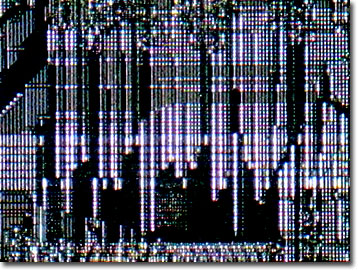Integrated Circuit Image Gallery
Intel Core Logic Integrated Circuit
As embedded microprocessors move into a wider array of consumer electronic devices and industrial production, the need to connect microprocessors, read-only memory (ROM), synchronous dynamic random access memory (SDRAM), and peripheral component interface (PCI) buses in an efficient manner created the demand for core logic chips. Intel designed the 21285 core logic device as a single-chip interface between the StrongARM SA-110 microprocessor and the other semiconductor components.

View a second image of the Intel logic chip.
Using the 21285 core logic device, system designers can create a wide array of PCI applications including office automation, interactive workstations, and internet-operating digital media. Optimizing the performance of embedded processors, the core logic chip features a PCI interface, synchronous DRAM interface for high-speed data transfer, and a flash ROM interface for initializing devices. Incorporated also in the Intel 21285 is direct memory access (DMA) interrupt controllers, programmable timers, an intelligent input/output (I/O) message unit, parallel and serial ports, and a PCI bus arbiter. Core logic functions are expanded to supplying four clocks for the SDRAMs and four chip selects. Each chip select can control from 1 megabyte to 64 megabytes of memory using 16-megabyte and 64-megabyte partitions.
Operating at 3.3 volts, the Intel core logic circuit is well suited for portable, battery-powered applications. With a maximum power dissipation of only 2.0 watts, the powerful logic chip does not create demands for bulky heat sinks or cooling fan units. By adding the 21285 to the basic SA-110 microprocessor, suitable applications for the embedded chipset expand to routers, printers, scanners, cellular base stations, local area networks/wireless area networks (LAN/WAN), advanced video game players, and network computers.
Contributing Authors
Omar Alvarado, Thomas J. Fellers and Michael W. Davidson - National High Magnetic Field Laboratory, 1800 East Paul Dirac Dr., The Florida State University, Tallahassee, Florida, 32310.
BACK TO THE INTEGRATED CIRCUIT IMAGE GALLERY
BACK TO THE DIGITAL IMAGE GALLERIES
Questions or comments? Send us an email.
© 1995-2025 by Michael W. Davidson and The Florida State University. All Rights Reserved. No images, graphics, software, scripts, or applets may be reproduced or used in any manner without permission from the copyright holders. Use of this website means you agree to all of the Legal Terms and Conditions set forth by the owners.
This website is maintained by our
Graphics & Web Programming Team
in collaboration with Optical Microscopy at the
National High Magnetic Field Laboratory.
Last Modification Friday, Nov 13, 2015 at 01:19 PM
Access Count Since September 17, 2002: 12666
Visit the website of our partner in introductory microscopy education:
|
|
